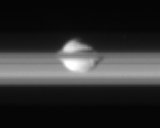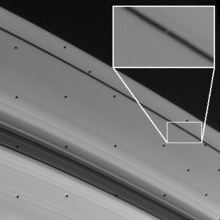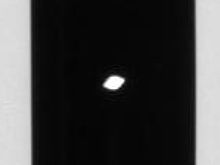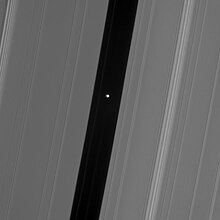Pan (moon)
| Pan | |
|---|---|

|
|
| Image of Pan by the Cassini spacecraft | |
| Provisional or systematic name | S / 1981 S 13 |
| Central body | Saturn |
| Properties of the orbit | |
| Major semi-axis | 133,584.0 ± 0.1 km |
| Periapsis | 133,582 km |
| Apoapsis | 133,586 km |
| eccentricity | 0.0000144 ± 0.0000054 |
| Orbit inclination | 0.001 ± 0.0004 ° |
| Orbital time | 0.575050718 d |
| Mean orbital velocity | 16.89 km / s |
| Physical Properties | |
| Albedo | 0.50 |
| Apparent brightness | 19.4 mag |
| Medium diameter | 28.4 ± 2.6 (35 × 32 × 21) km |
| Dimensions | 4.95 ± 0.75 x 10 15 kg |
| surface | ≈ 2,500 km 2 |
| Medium density | 0.41 ± 0.15 g / cm 3 |
| Sidereal rotation | 0.575050718 |
| Axis inclination | 0.0 ° |
| Acceleration of gravity on the surface | ≈ 0.002 m / s 2 |
| Escape speed | ≈ 7 m / s |
| Surface temperature | ≈ −195 ° C (78) K |
| discovery | |
| Explorer | |
| Date of discovery | July 16, 1990 |
| Remarks | Shepherd moon of the Encke division |

|
|
| The positions of the inner moons of Saturn in Saturn's ring system, from inside to outside Pan, Atlas, Prometheus, Pandora, Janus & Epimetheus, Mimas, Enceladus, Tethys, Dione and Rhea | |
Pan (also Saturn XVIII ) is the second (counting from the inside) and one of the smaller of the 82 known moons of the planet Saturn . It is the shepherd's moon of the Encke division and the inner one of the two moons within the A-ring of Saturn's rings .
Discovery and naming
Pan was discovered on July 16, 1990 by the astronomer Mark R. Showalter while evaluating images from the 1981 space probe Voyager 2 in the rings of Saturn.
The existence of a moon within the Encke division had already been predicted by Jeffrey N. Cuzzi and Jeffrey D. Scargle in 1985. The images taken by the Voyager 2 space probe showed wave patterns in the ring system that indicated gravitational disturbances. Showalter and other astronomers calculated in 1986 which celestial body could be responsible for the disturbances. They made a fairly precise prediction about its orbit (133,603 ± 10 km) and mass (5… 10 · 10 −12 Saturn's masses) and concluded that only a single moon could move within the division. The details of the orbit therefore only deviated by 19 km from the later observed, the actual mass is 8.6 · 10 −12 Saturn masses.
The moon was later found within 1 ° of the predicted position. All Voyager 2 photos were evaluated, and a computer was again used to calculate the conditions under which the moon should be best recognizable in each image. Pan was eventually visible on 11 Voyager images taken in the 48 hour period prior to the closest approach to Saturn. Every picture with a resolution better than 50 kilometers per pixel showed the moon clearly.
The discovery was announced on July 16, 1990 by the International Astronomical Union (IAU); the moon was initially given the provisional designation S / 1981 S 13 , which was dated back to 1981 due to the Voyager flyby. Pan was the 18th discovered moon by Saturn, which also corresponds to its Roman numbering XVIII . Until the discovery of S / 2009 S 1 on July 26, 2009, Pan was the innermost known moon of Saturn.

On September 16, 1991 it was named after Pan from Greek mythology . Pan was the son of Hermes , the progenitor of the satyrs and the shepherd and flock god. The name alludes to the function of the moon as a shepherd's moon. In terms of shape, it is a chimera made of a human upper body with a horned head with a beard and the lower body of a billy goat. Frightened by his figure, he was abandoned by his mother Dryope. Hermes took him to Olympus, where Pan was not given a seat and was brought to the island of Crete by Hermes .
According to other sources, Pan was a son of Zeus and Callisto or Zeus and the nymph Hybris . According to another story, Pan is a son of Kronos (Saturn) and Amaltheia , i.e. a half-brother of Zeus. Amaltheia, who is also described as a goat figure, was also Zeus' wet nurse.
The pan flute is named after Pan , and the word panic is also derived from his name. Due to his figure and his behavior, which was seen as voluptuous , the shepherd god Pan was negatively reinterpreted by Christianity from the Middle Ages and was often viewed as the personification of the devil. The equivalent in Roman mythology is Faunus , who was the grandson of Saturn .
From 1955 to 1975, the 1938 and discovered earlier than was Jupiter's moon XI known moon of Jupiter Carme sometimes Pan called.
Track properties
Orbit
Pan orbits Saturn on a prograde , almost perfectly circular orbit at an average distance of around 133,584 km (approx. 2,216 Saturn radii) from its center, i.e. 73,316 km above its cloud ceiling. The orbital eccentricity is 0.0000144, the orbit is inclined 0.001 ° to the equator of Saturn , so it lies exactly in the equatorial plane of the planet. Due to the low eccentricity, the path varies by only around 4 km.
The orbit of the next inner moon S / 2009 S 1 is on average about 16,500 km from Pan's orbit, the distance of the orbit of the next outer moon Daphnis is on average 2,921 km.
Pan orbits Saturn in 13 hours, 48 minutes and 4.4 seconds and thus needs about 2 hours and 28 minutes longer than its inner neighbor S / 2009 S 1 .
Pan is near a 16:15 resonance with Prometheus with a period of 108 days and an amplitude of about 3 km towards the orbit.
The moon orbits Saturn within a critical distance, the so-called Roche limit , which would cause a larger moon in this area to burst.
Pan ringlets
The moon runs around the planet in the 325 km wide Encke division of the A-ring named after Johann Franz Encke . It acts as a shepherd's moon and with its gravity causes the Encke division to remain largely free of ring particles.
The Encke division, which is approximately 3,000 km from the outer edge of the A-ring, contains a narrow ring ("ringlet") that coincides with Pan's orbit, indicating that Pan is maintaining the ring particles in a horseshoe orbit . A second, weaker, narrow ring is periodically perturbed by Pan , similar to the perturbations of the more outlying F ring by the moon Prometheus . Scientists have not observed any orbital disruption of the pan orbit caused by moons moving further out.
rotation
The rotation time is the same as the orbital time and Pan, like the Earth's moon , has a synchronous rotation , which also takes place within 13 hours, 48 minutes and 4.4 seconds. Its axis of rotation is exactly perpendicular to its plane .
Physical Properties
size
Pan has a mean diameter of 17 miles. In the recordings of the Cassini-Huygens - probe Pan appears as an irregularly shaped elongated object with dimensions 35 km x 32 km x 21 km, wherein the longitudinal axis is aligned with Saturn. Scientists from the Cassini mission described Pan as a walnut-shaped object with a bulge at its equator, similar to a pelmeni . This edge of the equator came about by collecting ring material from the Encke division. Other previously known moons with such comparable bulges are Atlas and Iapetus .
The total area of Pan is estimated to be 2,500 km².
internal structure
At 0.56 g / cm³, its mean density is far lower than that of Earth and even considerably lower than the density of Saturn; it is so low that Pan would swim on water. This indicates that the moon is predominantly composed of water ice .
The fact that Pan Saturn orbits within the Roche limit indicates that it either has a very solid internal structure, or that it belongs to the so-called rubble piles , which have cavities inside due to the comparatively weak gravity. Because of the extremely low mean density, the latter hypothesis is more likely.
surface
Pan has a high albedo of 0.5, which means that it has a bright surface that reflects 50% of the incident sunlight . On its surface, the acceleration due to gravity is 0.002 m / s², which corresponds to about 0.2 ‰ of that on earth. The mean surface temperature of Pan is estimated to be around −195 ° C (78 K ).
exploration
Due to the small size and apparent brightness of 19.4 m , which is 1: 30200000 of the central planet, as well as the close proximity to Saturn and the fact that it is outshone by it, Pan can hardly be made out with earth-based telescopes.
So far, Pan has been visited by three space probes, namely the flyby probes Voyager 1 on November 12, 1980 and Voyager 2 on August 25, 1981, and the Saturn orbiter Cassini , which orbited Saturn from July 1, 2004 to September 15, 2017. Pan has been targeted by Cassini several times, so its size and shape as well as orbital parameters are now fairly well known.
media
Web links
- IAUC 5052: Saturn July 16, 1990 (discovery)
- IAUC 5347: Satellites of Saturn and Neptune September 16, 1991 (designation)
- Time lapse on Youtube
- The peculiar shapes of Saturn's small inner moons (English)
Individual evidence
- ↑ Paul Rincon: Saturn overtakes Jupiter as planet with most moons. BBC , October 7, 2019, accessed March 20, 2020 .
- ^ The Orbits of Saturn's small satellites. Retrieved February 15, 2011 .
- ^ Saturnian Satellite Fact Sheet. Retrieved February 18, 2010 .
| further inside | Saturn moons | further outside |
| S / 2009 S 1 |
Semi- major axis (km) Pan 133,600 |
Daphnis |




